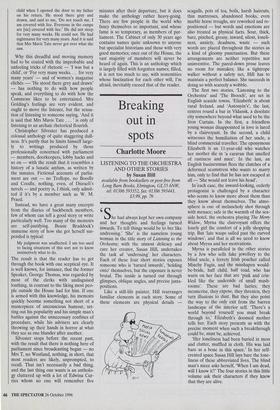Breaking out in spots
Charlotte Moore
LISTENING TO THE ORCHESTRA AND OTHER STORIES by Susan Hill available from booksellers or post-free from Long Barn Books, Ebrington, GL55 61VW, tel: 01386 593352, fax.• 01386 593443, £3.99, pp. 76 She had always kept her own company and her thoughts and feelings turned inwards. To tell things would be to her like undressing.' She' is the nameless young woman in the title story of Listening to the Orchestra; with the utmost delicacy and care her creator, Susan Hill, undertakes the task of 'undressing' her characters. Each of these four short stories exposes someone who is 'turned inwards', 'holding onto' themselves, but the exposure is never brutal. The inside is turned out through glimpses, oblique angles, and precise juxta- positions.
Like a still-life painter, Hill rearranges familiar elements in each story. Some of these elements are physical details — seagulls, pots of tea, boils, harsh haircuts, thin mattresses, abandoned books, even marble horse troughs, are reworked and re- positioned — but words and emotions are also treated as physical facts. Sour, thick, bare, pinched, greasy, inward, silent, loneli- ness, anxiety, deadness, waste — such words are placed throughout the stories as a kind of gloomy punctuation. But these arrangements are neither repetitive nor uninventive. The pared-down prose leaves no room for mistakes; like a tightrope walker without a safety net, Hill has to maintain a perfect balance. She succeeds in doing so with scarcely a wobble.
The first two stories, 'Listening to the Orchestra' and 'The Brooch', are set in English seaside towns, 'Elizabeth' is about rural Ireland, and 'Antonyin's', the last, centres round a bar in Vldansk, a desolate city somewhere beyond what used to be the Iron Curtain. In the first, a friendless young woman disappointed in love is lured by a clairvoyant. In the second, a child witnesses the humiliation of her uncle, a blind commercial traveller. The eponymous Elizabeth is an 11-year-old who watches her mother die in 'a caravan that smelled of rustiness and mice'. In the last, an English businessman flees the clutches of a deformed seamstress who wants to marry him, only to find that he has not escaped at all — 'She would not leave his head'.
In each case, the inward-looking, orderly protagonist is challenged by a character who seems to know more about them than they know about themselves. The atmo- sphere is one of melancholy shot through with menace; safe in the warmth of the sea- side hotel, the orchestra playing The Merry Widow, Myrna the clairvoyant offers the lonely girl the comfort of a jolly shopping trip. But 'late wasps sailed past the curved windows', and that is all we need to know about Myrna and her motivations.
Myrna is paralleled in the other stories by a Jew who sells fake jewellery to the blind uncle, a ferrety Irish poacher called Minchy Fagin, and the misshapen would- be-bride, half child, half toad, who has warts on her face that are 'pink and crin- kled like the underside of small mush- rooms'. These are bad fairies; they mesmerise, they expose, they threaten, they turn illusions to dust. But they also point the way to the only exit from the barren landscape of the interior self. 'There's a world beyond yourself you must break through to,' Elizabeth's doomed mother tells her. Each story presents us with the precise moment when such a breakthrough could be, must be, achieved.
`Her loneliness had been buried in mess and clutter, muffled in cloth. His was laid bare as a bone in this space.' In her self- created space Susan Hill lays bare the lone- liness of these abbreviated lives. The blind man's niece asks herself, 'When I am dead, will I know it?' The four stories in this little volume ask their characters if they know that they are alive.


















































































 Previous page
Previous page